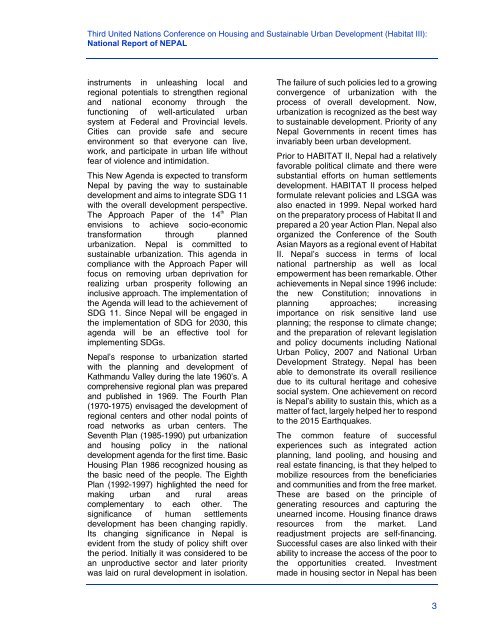Inclusive Cities Resilient Communities
Nepal-Habitat-III-National-Report
Nepal-Habitat-III-National-Report
Create successful ePaper yourself
Turn your PDF publications into a flip-book with our unique Google optimized e-Paper software.
Third United Nations Conference on Housing and Sustainable Urban Development (Habitat III):<br />
National Report of NEPAL<br />
instruments in unleashing local and<br />
regional potentials to strengthen regional<br />
and national economy through the<br />
functioning of well-articulated urban<br />
system at Federal and Provincial levels.<br />
<strong>Cities</strong> can provide safe and secure<br />
environment so that everyone can live,<br />
work, and participate in urban life without<br />
fear of violence and intimidation.<br />
This New Agenda is expected to transform<br />
Nepal by paving the way to sustainable<br />
development and aims to integrate SDG 11<br />
with the overall development perspective.<br />
The Approach Paper of the 14 th<br />
Plan<br />
envisions to achieve socio-economic<br />
transformation through planned<br />
urbanization. Nepal is committed to<br />
sustainable urbanization. This agenda in<br />
compliance with the Approach Paper will<br />
focus on removing urban deprivation for<br />
realizing urban prosperity following an<br />
inclusive approach. The implementation of<br />
the Agenda will lead to the achievement of<br />
SDG 11. Since Nepal will be engaged in<br />
the implementation of SDG for 2030, this<br />
agenda will be an effective tool for<br />
implementing SDGs.<br />
Nepal’s response to urbanization started<br />
with the planning and development of<br />
Kathmandu Valley during the late 1960’s. A<br />
comprehensive regional plan was prepared<br />
and published in 1969. The Fourth Plan<br />
(1970-1975) envisaged the development of<br />
regional centers and other nodal points of<br />
road networks as urban centers. The<br />
Seventh Plan (1985-1990) put urbanization<br />
and housing policy in the national<br />
development agenda for the first time. Basic<br />
Housing Plan 1986 recognized housing as<br />
the basic need of the people. The Eighth<br />
Plan (1992-1997) highlighted the need for<br />
making urban and rural areas<br />
complementary to each other. The<br />
significance of human settlements<br />
development has been changing rapidly.<br />
Its changing significance in Nepal is<br />
evident from the study of policy shift over<br />
the period. Initially it was considered to be<br />
an unproductive sector and later priority<br />
was laid on rural development in isolation.<br />
The failure of such policies led to a growing<br />
convergence of urbanization with the<br />
process of overall development. Now,<br />
urbanization is recognized as the best way<br />
to sustainable development. Priority of any<br />
Nepal Governments in recent times has<br />
invariably been urban development.<br />
Prior to HABITAT II, Nepal had a relatively<br />
favorable political climate and there were<br />
substantial efforts on human settlements<br />
development. HABITAT II process helped<br />
formulate relevant policies and LSGA was<br />
also enacted in 1999. Nepal worked hard<br />
on the preparatory process of Habitat II and<br />
prepared a 20 year Action Plan. Nepal also<br />
organized the Conference of the South<br />
Asian Mayors as a regional event of Habitat<br />
II. Nepal’s success in terms of local<br />
national partnership as well as local<br />
empowerment has been remarkable. Other<br />
achievements in Nepal since 1996 include:<br />
the new Constitution; innovations in<br />
planning approaches; increasing<br />
importance on risk sensitive land use<br />
planning; the response to climate change;<br />
and the preparation of relevant legislation<br />
and policy documents including National<br />
Urban Policy, 2007 and National Urban<br />
Development Strategy. Nepal has been<br />
able to demonstrate its overall resilience<br />
due to its cultural heritage and cohesive<br />
social system. One achievement on record<br />
is Nepal’s ability to sustain this, which as a<br />
matter of fact, largely helped her to respond<br />
to the 2015 Earthquakes.<br />
The common feature of successful<br />
experiences such as integrated action<br />
planning, land pooling, and housing and<br />
real estate financing, is that they helped to<br />
mobilize resources from the beneficiaries<br />
and communities and from the free market.<br />
These are based on the principle of<br />
generating resources and capturing the<br />
unearned income. Housing finance draws<br />
resources from the market. Land<br />
readjustment projects are self-financing.<br />
Successful cases are also linked with their<br />
ability to increase the access of the poor to<br />
the opportunities created. Investment<br />
made in housing sector in Nepal has been<br />
3


